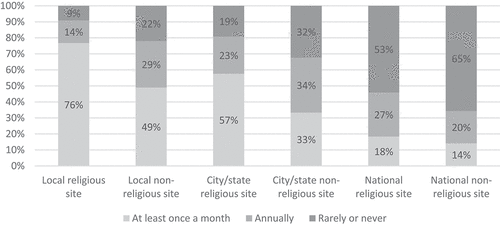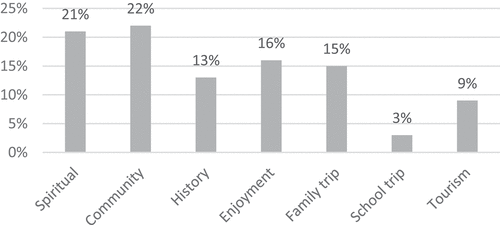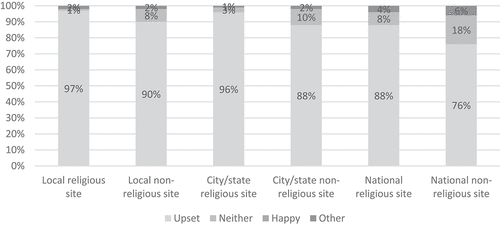ABSTRACT
The destruction of heritage in conflict has emerged as a key challenge to global security and the prospects of peace. In response, the international community has undertaken several large-scale heritage reconstruction projects on the assumption that they would foster development and promote cohesion. However, to date very little is understood about how local populations value their heritage, how they perceive its destruction, whether they view reconstruction as a priority, and the extent to which they support foreign efforts to rebuild. This article addresses this lacuna by focusing on the case study of Aleppo and documenting the results of an original public opinion survey of 1600 residents. The results hold several implications for heritage projects in Aleppo, namely that locals prefer that heritage reconstruction: not be privileged over security, development and peace; includes the rebuilding of their local religious sites as much as significant non-religious sites; transforms sites into more useful structures for the community; and they want domestic control and agency over the future of their heritage. The article concludes by noting that such findings hold important implications for heritage projects in other (post-)conflict contexts where mass heritage destruction has taken place.
Introduction
The destruction of heritage sites remains a persistent feature of modern conflict and is therefore seen as a significant challenge to international politics and global security (Christensen Citation2022; Russo and Giusti Citation2019). For example, throughout the many conflicts of both the twentieth and early twenty-first centuries, militant forces have repeatedly and deliberately targeted and destroyed heritage sites – from the atrocities of the First and Second World War, through ‘cultural cleansing’ campaigns in China or Cambodia, ethnic and religious conflict in Lebanon and the Balkans, US-led interventions in Iraq and Afghanistan, and down to ongoing conflicts in Ukraine, Sudan, Yemen, Myanmar, Israel-Palestine and elsewhere (Hassner Citation[2009] 2013; Meskell Citation2018).
Such destruction has not only prompted broad condemnation but also seen various multilateral agencies, international non-governmental organisations (INGO) and state bodies launch a suite of initiatives designed to protect and reconstruct heritage in complex (post-)conflict contexts. For example, UNESCO’s former Director-General Irina Bokova referred to the destruction of heritage sites by the Islamic State (IS) as ‘cultural cleansing’, arguing that they were ‘intended to destroy identities, tear apart social fabrics, and fuel hatred … [and therefore] cannot be decoupled from the killing of people’ (Bokova Citation2015, 40–1). This has led some to call for the Responsibility to Protect doctrine to be expanded beyond the protection of human life to significant heritage sites (Weiss and Connelly Citation2019) and for Cultural Peacekeeping forces to be integrated into international operations (Foradori and Rosa Citation2017). Another initiative has been to link the looting of heritage sites to the funding of terrorist groups. This led to the unanimous adoption of UN Security Council Resolution 2347 in 2017, the first dedicated exclusively to the security implications of the destruction of heritage in conflict (UNSC, Citation2017). As Peter Wilson, the British Ambassador to the UN, stated at the time, Resolution 2347 meant that the UNSC would now need to respond to heritage destruction ‘with the same intensity and the same unity of purpose as any other threat to international peace and security’ (Wilson Citation2017). A further example of recent global responses to heritage destruction has been efforts to prosecute the perpetrators under international law. In 2016 Ahmed Al-Mahdi of Ansar Al-Dine, was sentenced to nine years in prison in a landmark case at the International Criminal Court (ICC) for ordering the destruction of historic sites in Mali (Ba Citation2020).
However, perhaps the most prominent initiatives undertaken by international actors has been the launch of several ambitious projects to reconstruct heritage sites in (post-)conflict zones. As the world’s foremost multilateral body concerned with the preservation of heritage, UNESCO has long played a prominent role by arguing that heritage protection and restoration ought to be considered in any holistic approach to sustainable development and post-conflict recovery. For example, in 2015 UNESCO’s General Assembly adopted a resolution to integrate the principles of the UN’s Sustainable Development Goals into the processes of the World Heritage Convention (UNESCO, Citation2015). Here, UNESCO argued that heritage protection was not only vital to sustainable development, but also to the prevention of, and recovery from, conflict via its ability to promote economic rehabilitation, foster social cohesion and to advance global peace (Wiktor-Mach Citation2019). Towards these ambitious ends, UNESCO’s heritage reconstruction projects have seen them partner with and receive financial support from an array of other multilateral agencies such as the European Union (EU) and the World Bank, prominent heritage focused INGOs such as the Aga Khan Trust for Culture (AKTC) and the World Monuments Fund (WMF), and diverse state bodies including the US, UK and Japan as well as European and Gulf states.
However, these UNESCO-led heritage reconstruction projects have a mixed track record when it comes to using heritage to foster development, security and peace. For example, in Israel/Palestine, UNESCOs efforts to preserve historic sites exposed the tensions between their vision of heritage as a way to promote dialogue versus the state of Israel who have instead utilised heritage to entrench their control (Dumper and Larkin Citation2012). In Cambodia, UNESCO’s strategy to prioritise Angkor’s preservation in the hope of stimulating post-conflict economic recovery via tourism meant that those sites of everyday significance to local people remained neglected despite the scale of foreign investment (Esposito and Fauveaud Citation2019). Meanwhile, the post-war reconstruction of Beirut by a combination of foreign and domestic actors has been criticised for privileging renewed commercial and economic activity, appealing mostly to tourists and a few urban elites, over fostering social cohesion and a return to peace (Nagel Citation2002). And in Bosnia-Herzegovina, the UNESCO-led reconstruction of the Stari Most Bridge has been problematic not only because it failed to consult local communities, but also because it was seen as a carefully stage-managed affair designed as a symbol of stability in the centre of a region still riven with tension (Wollentz Citation2017). A very different scenario has played out in Afghanistan, where UNESCO has resisted local calls to reconstruct the Bamiyan Buddhas that were destroyed by the Taliban in 2001 in part because it would not meet their own strict criteria for ‘authenticity’ (Chiovenda Citation2014). Conversely, in Mali UNESCO abandoned the pretence of ‘authenticity’ in favour of restoring places of great value to the local community but have nonetheless been criticised for prioritising heritage restoration over addressing the extreme poverty and ongoing violence (Joy Citation2018). More recently, locals have expressed concerns about UNESCOs project to ‘Revive the Spirit of Mosul’, including questioning whether heritage reconstruction is really the most urgent priority and raising doubts over its capacity to play a meaningful long-term role in fostering peace in the deeply divided society left in the wake of the IS (Isakhan and Meskell Citation2019).
While these projects are undoubtedly well-intentioned, they reveal the complexities of (post-)conflict reconstruction and the limits of foreign efforts which seek to instrumentalise heritage to promote peace. They also reveal the significant gap between local public opinion and the broad array of multilateral institutions, INGOs and state bodies engaged in heritage. Indeed, very little is known about how the people most directly affected by the destruction value and engage with their rich and complex heritage, how they interpret its destruction and reconstruction, and the role they see for foreign and domestic actors in the restoration of heritage. Addressing this lacuna, this article focuses on the case study of Aleppo and offers the largest and most robust study to date of public opinion on projects to reconstruct key sites. It begins by outlining the human suffering and destruction unleashed by various forces in Aleppo since 2011. It then examines the myriad heritage projects undertaken across the city by both foreign and domestic actors. From here, the article documents key findings from an original survey of 1600 respondents from Aleppo. Our findings yield four significant implications for current and future heritage reconstruction efforts in Aleppo. Namely, while Aleppines take great pride in their heritage, they: would prefer that heritage reconstruction not be privileged over security, basic services and unemployment; would like to see their local and/or religious sites prioritised over the grandiose reconstruction of iconic sites that are of little personal significance; would like to see major reconstruction works transform sites into new and more useful structures for the community; and, perhaps most importantly, they want locals to have agency and control over the future of their past. The article concludes by noting that these empirical insights hold important lessons for heritage projects in other complex (post-)conflict environments.
Aleppo: the destruction and reconstruction of a city and its heritage
The protests that sparked Syria’s civil war came relatively late to the nation’s largest city, Aleppo. In August 2011, thousands of Aleppines spilled out onto the streets before being violently suppressed by Syrian armed forces. By July 2012, Aleppo had become one of the most dangerous frontlines of the entire conflict. Various rebel forces, especially the Free Syrian Army (FSA) and Islamist factions such as Jabhat al-Nusra, mounted several significant assaults on Aleppo, conquering the eastern part of the city and forcing the Syrian army into the west by March 2013. A four-year stalemate set in from July 2012 until July 2016 when Syrian troops – backed by Russian airpower and Shia militias, including those backed by Iran – closed the last supply lines of the opposition. In December 2016, the last of the rebels finally evacuated and the city fell back into the hands of the Syrian government.
The scale of human suffering and destruction in Aleppo since the onset of the civil war is difficult to capture in words. Hundreds of thousands were displaced and untold numbers of innocent civilians lost their lives to indiscriminate airstrikes, barrel bombings, asymmetric urban warfare, ethno-religious violence and summary executions (HRW, Citation2013). The heavy fighting in Aleppo also had significant consequences for the rich cultural heritage of the city. Among the destruction, the Old City of Aleppo – itself a UNESCO World Heritage site inscribed in 1986 and comprising scores of historic mosques, churches, markets and buildings – suffered terribly during the civil war. For example, the 12th century entrance to the Citadel of Aleppo was damaged by a missile attack during a clash between the FSA and Syrian forces in August 2012 (Hauslohner and Ramadan Citation2013). The following month a great fire swept through the Old City, destroying hundreds of stalls in Souq al-Madina, a thriving covered marketplace that dates back to the 14th century (UNESCO, Citation2012). The fire also damaged the 8th century Great Umayyad Mosque of Aleppo and, in April 2013, the mosques 45-metre high minaret was bombarded by heavy shelling and reduced to rubble (AP, Citation2013). A few blocks away, the National Museum of Aleppo was struck by several mortar rounds likely fired by rebel forces in July 2016, causing extensive damage to the structure of the building as well as some artefacts and archives inside (UN, Citation2016). Following the Syrian governments ‘victory’ in Aleppo in 2016, UNESCO led an emergency mission to assess the damage done to heritage sites across the Old City, concluding that about 60% had been severely damaged, with 30% completely destroyed (UNESCO, Citation2017). Beyond the Old City, untold numbers of other heritage sites were damaged and destroyed during the conflict including historic buildings, important churches and mosques, as well as local museums, libraries and art galleries.Footnote1
The destruction of Aleppo has prompted various initiatives to preserve and reconstruct the heritage of the city. While a number of reconstruction projects have been led by local community groups who appear to have acted independently, the principle focus here is on those conducted by multilateral agencies, INGOs and state actors. It is also important to note that many of these projects have been hamstrung by complex factors that include the ongoing security situation and the strict international sanctions limiting any work that is perceived to support the Syrian government. In addition, any external partner working on significant heritage reconstruction projects inside Syria is subject to the approval and scrutiny of the government. This has undoubtedly undermined the independence of these projects and means that the government has control over the selection of sites to restore, the precise nature and extent of the reconstruction, and therefore which areas and communities benefit most from the works. All of this has meant that several projects have had to be undertaken remotely from neighbouring countries.
One prominent example is UNESCOs ‘Emergency Safeguarding of Syrian Cultural Heritage’ project, a three-year initiative launched in March 2014 with $2.5 m in funding from the EU and an additional $430k from the governments of Bahrain, Austria and the regional government of Flanders (Belgium) (UNESCO, Citation2014a). Based out of UNESCO’s Office in Beirut, the project was principally designed to monitor Syria’s heritage, raise awareness among the international community and provide training to Syrian heritage professionals in the documentation of damaged heritage sites (UNESCO, Citation2014b). By 2018, UNESCO had partnered with UNITAR and received financial support from the Norwegian Ministry of Foreign Affairs to produce a comprehensive technical assessment of the destruction and rehabilitation of heritage sites across Aleppo, designed as a planning tool for the eventual reconstruction of the city (UNESCO/UNITAR, Citation2018). To date, however, UNESCO has been unable to execute any significant heritage reconstruction projects inside Syria.
Other UN agencies, such as the UNDP, have overcome the many challenges facing reconstruction efforts in contemporary Syria by including heritage restoration as part of their broader development work. With financial support from the Swiss and Japanese governments, the UNDP led the restoration of four souqs in the Old City. Concluded in June 2019, the project saw the restoration of around 150–200 stalls in the hope of recovering the livelihoods of shop owners and stimulating economic activity (UNDP, Citation2019b). In addition, the UNDP facilitated the restoration of the National Museum of Aleppo with further funding from the Government of Japan, which reopened to the public in October 2019 (UNDP, Citation2019a).
In terms of INGOs, the AKTC has also been able to undertake several projects inside Syria (McGivern Citation2018). With a budget of $400k they restored Souq al-Saqatiyya, a 150-metre section within Souq al-Madina that includes some 52 stores (Ibrahim Citation2020). The success of this pilot project was followed by the AKTC’s rehabilitation of several additional souqs, including some 380 shops (UNESCO, Citation2021). Another INGO known as the International Alliance for the Protection of Heritage in Conflict Areas (ALIPH) has also launched around 10 projects focused on preserving Syria’s heritage with a combined budget of $2 m and led by European partners from Germany, Switzerland, Denmark and Monaco. These include the creation of digital documentation of a historic church in the Aleppo Governorate led by a French team (ALIPH, Citationn.d.).
Paralleling these developments, a number of state actors have conducted their own Syria focused heritage initiatives. For example, from 2014 the US State Department has provided the American Society of Overseas Research at least $1.5 m to document the destruction of heritage sites in Syria and Iraq with additional funds provided by American INGOs such as the Getty Conservation Institute and the WMF (US, Citation2014). Similarly, the UK’s Cultural Protection Fund has provided over $3.5 m in backing for projects preserving Syria’s heritage, with one of the larger projects providing Syrian refugees in Jordan and Lebanon traditional stonemasonry skills to be used to repair conflict-affected heritage sites upon their return (BC, Citationn.d..). The German government has also funded various projects related to preserving Syria’s heritage. In 2013, the Museum of Islamic Art in Berlin and the German Archaeological Institute, with financial support from the German Foreign Office and the Gerda Henkel Stiftung, established the Syrian Heritage Archive Project (SHAP) to develop a systematic archive of photos and maps of Syrian heritage sites with the view to utilising them in any reconstruction efforts (SHAP, Citationn.d.).
The Syrian government and its key allies have also been responsible for various heritage reconstruction projects across Aleppo’s Old City such as: at the citadel where they have restored several historic structures; at the Al-Khabiya Souq, part of Souq Al-Medina, with support from the UNDP; and at several other mosques and public spaces (DGAM, Citation2021). The government has also undertaken several heritage reconstruction projects in partnership with its ally, Russia. For example, a construction company linked to the Syrian government has overseen the reconstruction of the Great Umayyad Mosque with an apparent investment of $14 m from the Chechen Republic of Russia, funded by the family of Chechen strongman leader and Putin protégé, Ramzan Kadyrov (Vasilyeva Citation2019). Another key Syrian ally in the war has been the Islamic Republic of Iran which has signed its own agreements for the reconstruction of Syria (Lob Citation2021). Several Shia militias, including those backed by Iran, have been active in protecting key Shia religious shrines, such as the Sayyida Zaynab shrine in southern Damascus (Isakhan Citation2020) and Iran is reportedly willing to actively participate in the reconstruction of other heritage sites across Syria (NPA, Citation2021).
Together these projects reveal the wide array of foreign stakeholders that have invested significant resources into the protection and reconstruction of Aleppo’s heritage. An assessment therefore ought to be made about the efficacy and legitimacy of these projects and the extent to which they are likely to further development, security, and peace. More to the point, there is very limited empirical data on how the people of Aleppo view the many foreign and domestic actors currently engaged in heritage reconstruction initiatives. Nonetheless, some scholars have been deeply critical of efforts to reconstruct heritage sites across Syria, arguing alternatively that: heritage sites should not be rebuilt while the conflict continues and the humanitarian situation remains grim (Munawar Citation2017); that such reconstruction may in fact serve to bolster the Syrian governments authoritarian rule and its allegiance to foreign actors like Russia and Iran (Van Veen Citation2019); and that the existing reconstruction efforts lack legitimacy given they have failed to adequately engage with local stakeholders (Alsalloum Citation2019). In addition, a handful of important studies have conducted qualitative interviews with Syrians, capturing their nuanced memories of heritage prior to the war and the role that heritage may play in a peaceful future (Azzouz Citation2019, Citation2020). Focusing on Aleppo, others have documented the complex visions that locals hold for the reconstruction of heritage sites as diverse as the historic souqs and the traditional houses of the Old City (Kousa, Pottgiesser, and Lubelli Citation2021; Mahfouz Citation2021). In terms of existing survey data, there are very few examples of rigorous representative data that capture attitudes to the reconstruction of Aleppo and its heritage. One example is the surveys conducted by the Aleppo Project from 2014–15 which were a mix of online and in-person surveys with a majority of respondents living outside of Syria, primarily in Turkey. Although this survey was not explicitly focused on heritage, it did ask questions about respondents’ memories of public spaces and spiritual sites, as well as their priorities for the future reconstruction of the city (TAP Citation2014–15). More recently, one study has documented the results of a survey of Iraqi and Syrian participants on their attitudes to post-conflict heritage reconstruction in general (Munawar and Symonds Citation2022) and another has focused on public opinion of heritage projects in post-IS Mosul (Isakhan and Meskell Citation2023). Both emphasise that locals are critical of heritage projects and would like to be consulted in reconstruction efforts. To further these initial works, the remainder of this article documents the research design, results and conclusions drawn from the largest study to date of local public opinion on heritage related issues in Aleppo.
Research design and limitations
This article uses the case study of Aleppo to examine local public opinion on heritage, its destruction and reconstruction, and the extent to which this converges with or diverges from the actions of domestic and international actors to restore the heritage of the city. The article therefore documents and analyses the results of an original survey of public opinion regarding how locals value and engage with their heritage, experience its destruction and want to see it reconstructed. The authors designed the survey in collaboration with scholars from the Arab BarometerFootnote2 before it was administered by the Beirut-based Statistics Lebanon.Footnote3 The survey was conducted in Arabic over 14 April to 25 May 2022 to 1600 respondents via telephone. It was specifically designed as a representative survey administered to a random sample of all adult citizens (18 plus) currently living in the various neighbourhoods of Aleppo at the time of the survey. To do so, the city of Aleppo was divided into 30 sub districts, known as Primary Sampling Units (PSU) using standard probability-proportional-to-size procedures. Within each PSU, an average of 137 people were contacted via telephone, with a response rate of 39% completing the survey. With an average of 53.4 surveys successfully conducted in each of the 30 PSUs, the study reached a total of 1600 respondents. The surveys were conducted anonymously to encourage frank responses and to respect the safety and political exposure of participants. The study has been conducted in accordance with the ethical standards of the Deakin University Human Research Ethics Committee, Australia.
The survey itself consisted of 60 questions across six main parts. Part I included 10 questions designed to examine the complex ways in which respondents value and engage with their heritage, including how often they visit and how highly they value different types of sites. In Part II of the survey, we asked respondents’ a further 10 questions which gauged their reactions to the destruction of heritage since the onset of the civil war. Part III was made up of another 10 questions which focused on participants’ views on the reconstruction of heritage sites, including how heritage reconstruction ranks against other developmental and humanitarian needs and the form of heritage reconstruction they would most like to see. Then Parts IV and V of the survey consisted of 12 questions (five and seven, respectively), designed to assess respondents’ opinions on the role that the Syrian government (Part IV) and international actors (Part V) have played in the reconstruction of Aleppo’s heritage and who they would most like to see responsible for the ongoing rehabilitation of the city.
The final section of the survey, Part VI, included a battery of 16 demographic questions. These revealed that the respondents were spread across several age groups: 18–29 (26%), 30–39 (31%), 40–49 (25%), 50–59 (11%) and over 60 (2%). The survey had gender parity (50% male and female) and a bias towards those who were married (69%). A slim majority of respondents had completed high school (51%) with 16% completing subsequent education; only 4% had no formal education. A slim majority of respondents were not currently employed full-time (53%) with 44% in full-time work. In terms of identity, 97% considered their national identity to be Syrian (3% identified as Syrian-Kurdish), 89% described their ethnic identity as Arab (6% Kurdish, 3% Armenian/Assyrian or other Christian and 1% Turkmen); and 93% identified their religious identity as Muslim (5% Christian, 1% Yezidi). In terms of religiosity, 89% reported their level of religious commitment as ‘High’ (34%) or ‘Moderate’ (55%) and 91% reported that they closely adhered to the practices of their religion. Finally, in terms of political affiliation, 83% supported the current Syrian government and believed they were the only legitimate political actor. Regarding this high level of support for the Syrian government, it is worth noting that the survey was conducted in a time of heightened insecurity and fear of the government which itself follows several decades of brutal state repression (Ismail Citation2018).
Before proceeding to document the results of the survey, it is important to acknowledge a few limitations. Firstly, both the ongoing security situation and strict international sanctions prevented us from conducting the survey in-person inside Aleppo. The project was approved by the US Office of Foreign Assets Control (OFAC) on the strict condition that we only conduct the study remotely (via phone) and that we did not deliberately survey anyone affiliated with the Syrian government. Secondly, the rapid demographic changes that Aleppo has seen in recent years undoubtedly shaped our results. Aleppo and its surrounds have traditionally been home to a diverse mix of ethnic and religious groups, something which has changed dramatically since the civil war triggered waves of mass exodus. The World Population Review estimates that Aleppo reached a pre-war population of over 3 million in 2010 which shrunk to just 600,000 in 2014 and returned to over 2 million by the time of our survey in 2022 (WPR, Citation2023). This rapid fluctuation, coupled with the fact that the city’s minority communities are more likely to have fled and less likely to have returned, means that the contemporary population of Aleppo is relatively homogenous when compared to its diverse past. This has implications for the ways in which Aleppo’s current population engage with the city’s heritage. For example, it is reasonable to expect that Christian sites were more frequently visited and highly valued when Aleppo was home to a higher proportion of Christians than it is today. The survey documented in this article is therefore a snapshot of the city’s residents and their opinions on heritage in April-May 2022. Future longitudinal studies of ethnically and religiously diverse cities may be able to capture the extent to which changing demographics alter the complex relationship between local populations and their heritage.
Results
Part I: how do the people of Aleppo value and engage with their heritage?
In Part I of the survey, we sought to identify the complex ways in which the people of Aleppo value and engage with their heritage. To begin with, we asked them to respond to the statement ‘I am very proud of the rich cultural heritage of this country’, and provided them with a four-point Likert scale from ‘strongly agree’ to ‘strongly disagree’. As reveals, the overwhelming majority agreed (98%), made up of those who ‘strongly agree’ (40%) and ‘agree’ (58%), leaving only 1% who disagreed. This indicates that the majority of Aleppo’s residents feel immense pride in the cultural heritage of their country.
Figure 1. Do you agree with the following statement: ‘I am very proud of the rich cultural heritage of this country?Footnote4
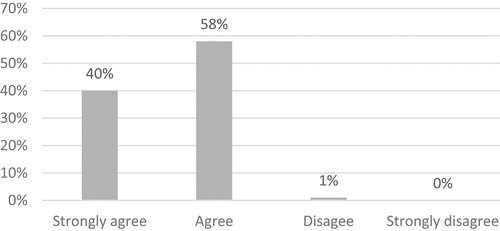
We also sought to establish how often respondents visited specific heritage sites and, despite how often they visited, how important these were to them personally. To do so, we operationalised two different types of sites: religious sites which we defined as ‘a mosque, church, shrine or other religious site’; and non-religious sites such as ‘a museum, historical building, or pre-Islamic archaeological site’. We also proposed three different locations: local by which we meant the nearest or most accessible site; city/state which we defined as those sites across Aleppo City and Governorate; and national which included heritage outside their governorate. As shown in , when we asked respondents ‘How often do you visit the following heritage sites?’, they most frequently visited ‘local religious sites’ which 76% of respondents visited at least once a month; and the least frequently visited places were ‘national non-religious sites’ which 65% claimed to have ‘rarely or never’ visited.
This was relatively consistent to the results of a subsequent question in which we asked respondents’ ‘Despite how often you visit, how important are the following heritage sites to you personally?’ As documented in , 98% of respondents ranked their ‘local religious sites’ as important and the least important were ‘national non-religious sites’ (78%).
Figure 3. Despite how often you visit, how important are the following heritage sites to you personally?

Overall, the frequency of visits and the importance attached to heritage sites appears to be shaped by two variables. Firstly, in terms of religion, respondents consistently reported that they both visited and valued religious sites over non-religious sites regardless of location. Secondly, in terms of proximity, respondents were understandably more likely to visit and value local sites than those outside of their immediate vicinity. This is in part driven by convenience, but also likely effected by the dynamics of the conflict itself, where escalations in violence and restrictions on movement made it increasingly difficult and unsafe to travel. Interestingly, proximity and frequency of visits does not appear to significantly shape perceptions of a site’s importance, with religious sites consistently ranked as more important than non-religious ones, regardless of their location.
We also sought to understand respondents’ reasons for visiting sites, asking the multiple choice question, ‘Of the heritage sites that you have visited, what was the primary reason to visit?’ and then presenting them with seven options. As shown in , the most frequent response was ‘To be with my community’ (22%), followed closely by ‘Spiritual reasons’ (21%), then ‘I enjoy visiting heritage sites’ (16%) and for a ‘Family day trip or picnic’ (15%). Such results demonstrate that while the local community may mostly visit and value religious sites, their motives to do so go beyond spirituality.
Altogether, we found that the majority of respondents reported being very proud of the rich cultural heritage of Syria and were more likely to visit and value local heritage sites than those across their city/state or elsewhere in the country. We also found that respondents were more likely to visit and value religious than non-religious sites, regardless of location. This is perhaps not surprising given that respondents reported high levels of religious commitment and observance. However, our interlocutors also visited heritage places for myriad different reasons that went beyond the spiritual, including community, pleasure and family trips.
Part II: how do the people of Aleppo interpret the destruction of their heritage?
In Part II of the survey, we sought to identify the ways in which the people of Aleppo interpreted the destruction of heritage sites. We therefore asked respondents ‘Overall, how would you describe your feelings when heritage sites were destroyed during the recent conflicts?’ and presented them with a five-point Likert scale that ranged from ‘very upset’ to ‘very happy’. As reveals, the vast majority felt upset by the destruction of heritage sites (99%), including those who felt ‘very upset’ (63%) and ‘somewhat upset’ (36%) – with only 1% feeling ‘neither upset nor happy’. This indicates that most of Aleppo’s residents did not support the destruction of heritage sites by various actors during the civil war.
Figure 5. Overall, how would you describe your feelings when heritage sites were destroyed during the recent conflicts?
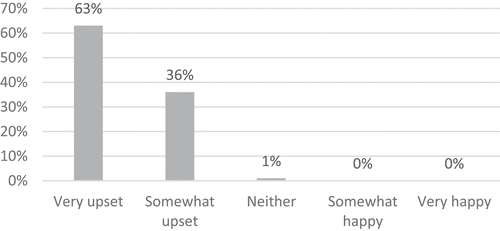
We also wanted to measure respondents’ complex reactions to the destruction of different heritage sites in conflict. Following earlier questions, we therefore asked ‘How did you react to the damage and destruction at the following heritage sites?’ and then identified two different types of sites (religious and non-religious) across three different locations (local, city/state, national). As shown in , respondents tended to be slightly more upset by the destruction of religious sites across their local area (97%), their city or governorate (96%) or country (88%) than non-religious sites (90%, 88% and 76% respectively). However, while the rates at which they frequented specific sites or ranked their level of importance varied across different types of sites and location, they still overwhelmingly reported feeling upset when heritage sites were damaged, regardless of their religious value or proximity. A few other things are worth noting here: 0% of respondents reported being ‘happy’ about the destruction of heritage sites, regardless of type or location; respondents were slightly more ambivalent (‘neither upset nor happy’) about the destruction of non-religious than religious sites, regardless of location; and some respondents gave other responses such as ‘don’t know’ or reporting that the site in question was ‘undamaged’.
Furthermore, we wanted to ascertain what Aleppines believed to be the key motivations driving attacks on heritage sites. We therefore asked: ‘What do you think was the principal reason for most of the heritage destruction during the conflict in Syria?’ and prompted them to choose one of seven options. As can be seen in , the most prominent answers were ‘Looting for revenue’ (25%), ‘Religious extremism’ (22%) and ‘Anger at the Syrian state’ (17%). This indicates that while respondents did understand religious extremism as a key motive of the damage, they also thought that much of it was driven by other factors.
Figure 7. What do you think was the principal reason for most of the heritage destruction during the conflict in Syria?
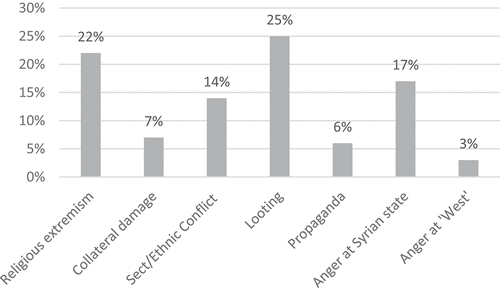
We also wanted to understand the extent to which respondents viewed heritage destruction as permissible under their religion. As noted above, 93% of respondents identified as Muslim with high levels of religious commitment and observance. We therefore wanted to examine if they thought that heritage destruction had any religious justification. To do so, we asked respondents: ‘Do you agree with the following statement: “Some teachings in my religion say that it is permissible to deliberately destroy heritage sites”?’ and then presented them with a four-point Likert scale from ‘strongly agree’ to ‘strongly disagree’. As can be seen in , 84% of respondents disagreed (42% ‘strongly disagree’, 42% ‘disagree’) with a minority of 13% agreeing (3% ‘strongly agree’, 10% ‘agree’).
Figure 8. Do you agree with the following statement: ‘Some teachings in my religion say that it is permissible to deliberately destroy heritage sites?’.
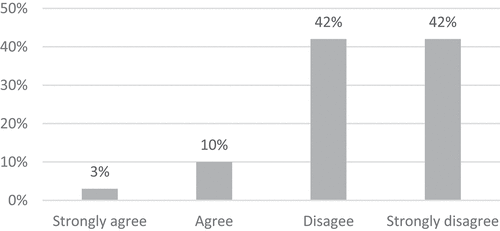
Overall, we found that the majority did not support the destruction of heritage sites. This appeared to be consistent irrespective of whether the site in question was religious or non-religious, or in their local area or not. Respondents also shared an acute awareness of the complex motives that drove the destruction and believed that it was not permitted in the teachings of their religion, with only a slim minority contradicting this view.
Part III: how do the people of Aleppo view the reconstruction of their heritage?
Part III of the survey examined the ways in which the people of Aleppo viewed the reconstruction of their heritage sites. We began by attempting to gauge whether, and to what extent, restoration of cultural heritage was a priority given all of the other urgent needs facing the people of Aleppo. We therefore asked: ‘If you had to choose just 3, which of the following do you think are the most urgent priorities for the future of Syria?’ and presented them with a list of 10 options. As can be seen in , the top answers were: ‘safety and security’, (60%); ‘electricity, water and other services’ (56%), ‘unemployment and poverty’ (35%); and ‘a political solution’ (33%). However, just less than one-third (31%) of respondents listed ‘heritage protection and reconstruction’ in their top three urgent priorities for the future of Syria. This indicates that heritage reconstruction is a relatively low priority for the people of Aleppo, even though various foreign and domestic actors are dedicating significant resources to rebuilding heritage across the city.
Figure 9. If you had to choose just 3, which of the following do you think are the most urgent priorities for the future of Syria?
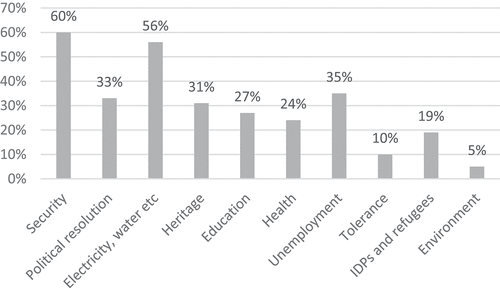
However, we also wanted to ask the people of Aleppo what their overall attitude to heritage restoration efforts was, assuming that such programmes would continue regardless. We therefore asked if they agreed with the statement: ‘Heritage sites that were damaged or destroyed during recent conflicts should be restored or reconstructed’ and presented them with a scale from ‘strongly agree’ to ‘strongly disagree’. As shown in , the overwhelming majority (98%) of respondents agreed with the statement (38% ‘strongly agree’, 60% ‘agree’) – with just 2% choosing to ‘disagree’ (1% ‘strongly disagree’, 1% ‘disagree’).
Figure 10. Do you agree with the following statement: ‘Heritage sites that were damaged or destroyed during recent conflicts should be restored or reconstructed?’.
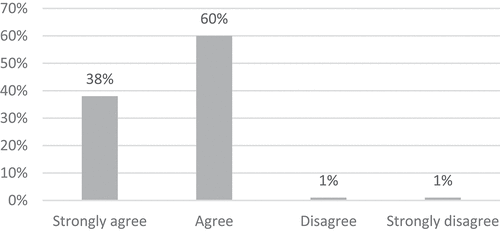
We also wanted to enquire as to which sites the respondents would most like to see reconstructed across different types of sites (religious, non-religious) and locations (local, city/state, national). Mirroring earlier questions, we therefore asked ‘Which of the following heritage sites would you most like to see restored or reconstructed?’ As shown in , respondents showed a clear preference for the reconstruction of religious sites, regardless of location (97% for local, 96% for city/state and 91% for national sites); non-religious heritage sites were seen as slightly less important to reconstruct than religious sites across locations (88%, 86%, 78% respectively).
Figure 11. Which of the following heritage sites would you most like to see restored or reconstructed?
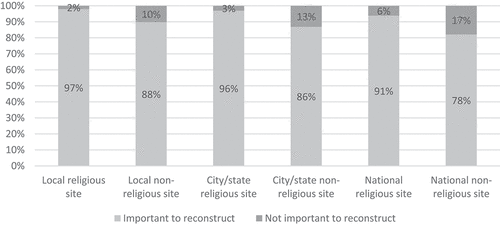
We also sought to determine what form the respondents would like heritage restoration to take. Therefore we asked: ‘What would you prefer to see happen to the heritage sites that have been damaged or destroyed during the recent conflicts?’ and presented them with a list of six possible answers. As can be seen in , only 1% would prefer that the sites be left in ruins. Of the remainder, the majority (57%) preferred that the reconstruction focus less on upholding the historical integrity of the site and more on transforming them into more modern facilities, including those who wanted to see the incorporation of new and practical structures (30%) and to make sure the site can be useful again to a community (15%). Others preferred that former heritage sites not be restored, but instead developed into entirely new facilities (12%). Nonetheless, a considerable number did aspire to see the historical authenticity of the site restored (41%), including returning sites to their pre-war (24%) or original historical form (17%).
Figure 12. What would you prefer to see happen to the heritage sites that have been damaged or destroyed during the recent conflicts?
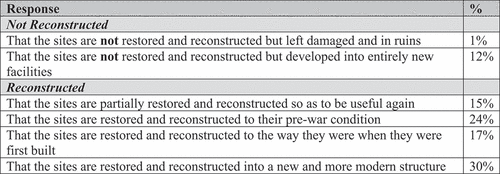
In sum, we found that very few respondents considered heritage reconstruction to be among the most urgent priorities facing contemporary Syria. However, assuming that heritage reconstruction was to continue regardless, it garnered broad support from Aleppines. Consistent with how often they visit, how highly they value and the extent to which they lamented the destruction, respondents identified a slight preference for the rebuilding of religious sites over non-religious sites, with the strongest support for the reconstruction of their local religious sites. Beyond this, the people of Aleppo also held specific views about how they would like to see the works done, with the largest number hoping to see damaged sites rebuilt into new and more modern structures with less support for restoring historical integrity.
Part IV and V: what role do the people of Aleppo see for national and international actors?
Finally, we measured respondents’ opinions on the role that the Syrian government (Part IV) and international actors (Part V) had played in the reconstruction of Aleppo’s heritage and who they would most like to see in charge of such projects in the future. We therefore asked two related questions: ‘Which actor do you think has done the most to restore or reconstruct heritage sites across Syria?’; and ‘If you had to choose just one, who would you most like to see being entrusted with any restoration or reconstruction work at heritage sites?’ After each question, we presented a list of 14 actors, from ‘ordinary Syrians’, domestic state and non-state actors, to foreign states, INGOs and multilateral institutions. As can be seen in , the first question revealed that the largest number named the Syrian government (40%) and ordinary Syrians (21%); followed at some distance by INGOs such as the AKTC and the WMF (6%), multilateral bodies such as UNESCO (4%) and the Gulf States (3%). Only 2% saw Western governments like the US, UK and Europe as having done the most to restore heritage sites across Syria, a similar number to other actors such as Russia (2%) and Iran (1%). This is consistent with results from the second question where the largest number named the Syrian government (31%) and ordinary Syrians (20%); followed by global agencies such as UNESCO (13%), the Gulf States (10%) and INGOs (9%); with just 4% support for Western governments; and very limited support for Russia (2%) or Iran (1%) to spearhead heritage projects across Aleppo in the future.
Figure 13. Which actor do you think has done the most to restore or reconstruct heritage sites across Syria?; and ‘If you had to choose just one, who would you most like to see being entrusted with any restoration or reconstruction work at heritage sites?’.
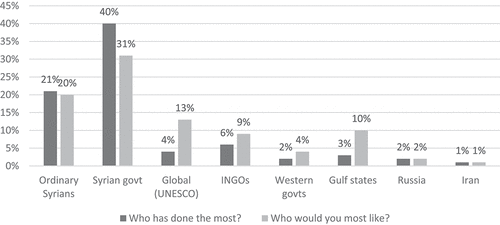
We also asked a battery of six questions designed to elicit an assessment of the efforts made thus far by both the Syrian government and international actors. The first three enquired as to whether respondents thought that the ‘Syrian government’ was doing enough to: ‘promote heritage and educate people about the rich heritage of this country’; ‘to restore and reconstruct heritage sites after conflict’; and to ‘engage with and listen to the Syrian people when it comes to heritage’. The second set of three questions repeated the above but this time focused on how ‘International actors such as UNESCO and Western governments such as the US and UK’ were perceived to be performing. As can be seen in , the Syrian government was perceived as better at educating the people of Aleppo about heritage (75%), restoring and reconstructing sites (75%) and at listening to and engaging with the Syrian people on heritage (67%), than foreign actors (62%, 58%, 58% respectively).
Figure 14. The Syrian government/International actors are doing enough to: promote heritage and educate people about the rich heritage of this country; restore and reconstruct heritage sites after conflict; and engage with and listen to the Syrian people when it comes to their ideas on heritage, its destruction and reconstruction.
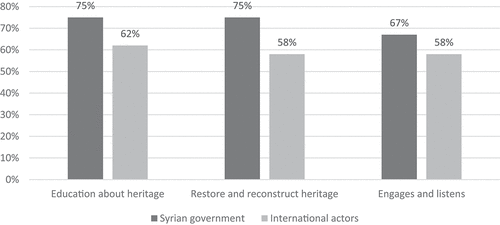
These results reveal that Aleppines do not readily acknowledge the role played by multilateral agencies, INGOs or foreign states in heritage reconstruction to date and neither do they want these actors to lead such projects into the future. Instead, they acknowledged the role already played by the Syrian government and ordinary Syrians and wanted them to be entrusted with the ongoing reconstruction of heritage. Despite the significant investment by international actors, they were seen as having done the least to date and were the least supported to lead further heritage reconstruction projects. Furthermore, respondents also thought that the Syrian government was better at educating people about heritage, reconstructing key sites and listening to the Syrian people on heritage matters than their international counterparts. It is however important to note that such high support for the Syrian government is likely shaped by wanting to appear supportive of, or compliant with, the government out of fear of repercussions. Nonetheless, the fact that ‘ordinary Syrians’ were rated as having done more to date and were preferred to lead reconstruction over multilateral institutions, INGOs or foreign governments, attests to the desire for domestic control over heritage. Similarly, regardless of how highly the Syrian government was rated on its capacity to educate, reconstruct or listen to people about heritage matters, international actors were ranked independently of this as having performed poorly in these regards.
Conclusion
In response to the destruction of heritage across Aleppo, a number of multilateral institutions, INGOs and state actors launched ambitious projects to protect and reconstruct key sites across the city. These are important and meaningful initiatives that could play a transformative role in the future of the city. However, such projects appear to rely on a set of problematic assumptions about how the people of Aleppo value and engage with their heritage, how they perceive its destruction, their views on reconstruction, and that they would want external actors to intervene. This article has held these assumptions up to empirical scrutiny via the largest study to date of Syrian public opinion concerning heritage. In broad terms, our results indicate that the vast majority of Aleppines take great pride in their heritage, did not approve of its destruction, and support reconstruction in general.
The results also hold four specific implications for current and future heritage initiatives in Aleppo. First, less than a third of respondents considered the reconstruction of the material past to be among the most urgent priorities facing Aleppo. Having endured over a decade of violence, poverty and war, Aleppines instead hoped for improvements in security, basic services and employment. This finding contrasts sharply with the growing tendency of various INGOs and multilateral organisations to argue that the reconstruction of heritage is essential to fostering sustainable development, security and peace. As just one example, UNESCO has stated that their Emergency Safeguarding of Syrian Cultural Heritage project will ‘contribute to restoring social cohesion, stability and sustainable development through the protection and safeguarding of cultural heritage’ (UNESCO, Citationn.d..). While such goals are admirable, the track record on heritage projects playing a meaningful long-term role in fostering peace is not especially strong. In the case of Lebanon, the Balkans, Mali and Iraq, broader development needs were sidelined in favour of heritage projects that are then celebrated as symbols of peace despite ongoing insecurity and destruction. In Aleppo, both foreign and domestic actors ought to remain cognisant of the fact that heritage reconstruction cannot be done in isolation from, or as a proxy for, other developmental and humanitarian needs.
Second, and assuming that heritage reconstruction is to go ahead, the data reveals important findings regarding the extent to which proximity and religion determine the significance of different types of heritage to the people of Aleppo. In terms of proximity, this indicates that iconic sites, such as the Great Umayyad Mosque, which may be difficult to access for the majority of Allepines could therefore be less important to reconstruct than more accessible local sites. Similarly, in terms of religion, it may be wiser for heritage projects to prioritise religious over non-religious sites, like the Aleppo Museum, which are rarely visited by the respondents. This resonates with earlier experiences in other contexts such as Cambodia where the exclusive focus on iconic places like Angkor came at the expense of sites of everyday importance to local communities. In Aleppo, both foreign and domestic actors could seize the initiative to work more closely with local communities and religious leaders, supporting their initiatives and developing their capacity to restore the sites that are most significant to them.
Third, the people of Aleppo also hold specific views on the form they would like heritage reconstruction to take, preferring that damaged structures be transformed into new and more modern facilities that are useful to the community over projects that aim to match historical or pre-war conditions. This is in conflict with UNESCO’s comprehensive long-term plan to reconstruct some 250 structures across the city where they intend to ‘rebuild the Old City exactly as it was before the war, with the same stones where we can’ (McDowall Citation2017). This points to a long-standing dichotomy in heritage practice between preserving the ‘authenticity’ of sites and developing something useful to a living community. In Afghanistan, this tension manifested in a stalemate between locals who would prefer the Bamiyan Buddhas be restored in the hope of stimulating tourism versus foreign agencies like UNESCO who have argued against the reconstruction since it would not meet their own criteria for ‘authenticity’. In Aleppo, while there is some support for restoration that privileges the historical integrity of the site, most respondents understandably want to see sites developed into new and practical public infrastructure.
A final implication of this study for heritage reconstruction projects in Aleppo is that respondents did not think that multilateral actors, INGOs, or foreign governments had done much to restore heritage to date and expressed very low levels of support for their involvement in the future. Instead, they acknowledged the work already done by the Syrian government and ordinary people in reconstruction and wanted them responsible for leading such efforts into the future. Respondents also believed that the Syrian government was better than foreign actors at educating locals about heritage, restoring key sites after conflict, and listening to the Syrian people about their ideas on heritage. This is important because it contrasts against the significant claims made by many international actors that they are actively engaging with, and sensitive to, local communities.
Together, these findings present a series of challenges to current and future heritage initiatives in Aleppo. They demand that foreign and domestic actors work to ensure that heritage reconstruction is embedded within broader programmes to foster peace, to re-think their existing preference for restoring iconic and/or non-religious sites, reconsider the idea that reconstruction works ought to meet specific criteria of ‘authenticity’, and to ensure that all such works genuinely consult with and empower local peoples to be the future custodians of their past. Such findings are also relevant beyond the case of Aleppo, advancing scholarly understandings of the complex and contested relationships between heritage and conflict. Further research is needed to catalogue the ways in which communities living in (post-)conflict contexts perceive heritage destruction and the role they see for international intervention. Such research could be done in partnership with multilateral agencies, state actors and INGOs currently invested in large-scale heritage projects so that their efforts are cognisant of local sentiment and tailored to best meet the needs of local communities. It is hoped that such awareness will help prevent future initiatives from being insensitive to the nuanced opinions of the local populations whose heritage they seek to rebuild.
Disclosure statement
No potential conflict of interest was reported by the author(s).
Additional information
Funding
Notes on contributors
Benjamin Isakhan
Benjamin Isakhan is Professor of International Politics and Founding Director of Polis, a research network for Politics and International Relations in the Alfred Deakin Institute at Deakin University, Australia. He is also an Adjunct Senior Research Associate, Department of Politics and International Relations, Faculty of Humanities at the University of Johannesburg. He can be reached at: [email protected]
Lynn Meskell
Lynn Meskell is Penn Integrates Knowledge (PIK) Professor at the University of Pennsylvania. She is Richard D. Green Professor in the Department of Anthropology, School of Arts & Sciences, Professor in the Department of Historic Preservation at the Stuart Weitzman School of Design, and Curator in the Middle East Section of the Penn Museum. She is also AD White Professor-at-Large at Cornell University.
Notes
1. While there is no definitive list of all of the heritage sites that have been damaged or destroyed in Aleppo, we refer readers to the reports produced by the American Schools of Overseas Research (ASOR), available at: https://www.asor.org/chi/reports/weekly-montly.
2. See: https://www.arabbarometer.org.
3. See: https://www.statisticslebanonltd.com.
4. Note that the data presented in the various tables and charts in this article may not always add up to 100% either because respondents sometimes answered ‘don’t know’, they declined to answer a question, or because numbers have been rounded up. Also note that some responses have been grouped together for ease of presentation. For example, in , ‘rarely’ and ‘never’ have become ‘rarely or never’.
References
- ALIPH. n.d. “Project(s) Supported in Northeastern Syrian and Syrian Heritage.” International Alliance for the Protection of Heritage in Conflict Areas. Accessed August 5, 2022. https://www.aliph-foundation.org/en/actions-country/SY.
- Alsalloum, A. 2019. “Rebuilding and Reconciliation in Old Aleppo: The Historic Urban Landscape Perspectives.” In Reshaping Urban Conservation: The Historic Urban Landscape Approach in Action, edited by A. P. Roders and F. Bandarin, 57–78. Singapore: Springer.
- AP. 2013. “Minaret of Historic Syrian Mosque Destroyed in Aleppo.” The Guardian.
- Azzouz, A. 2019. “A Tale of a Syrian City at War: Destruction, Resilience and Memory in Homs.” City 23 (1): 107–122.
- Azzouz, A. 2020. “Re-Imagining Syria: Destructive Reconstruction and the Exclusive Rebuilding of Cities.” City 24 (5–6): 721–740.
- Ba, O. 2020. “Contested Meanings: Timbuktu and the Prosecution of Destruction of Cultural Heritage As War Crimes.” African Studies Review 63 (4): 743–762.
- BC. n.d. “Cultural Protection Fund Projects: Syria.” British Council. Accessed August 5, 2022. https://www.britishcouncil.org/arts/culture-development/cultural-protection-fund/projects/syria.
- Bokova, I. 2015. “Fighting Cultural Cleansing: Harnessing the Law to Preserve Cultural Heritage.” Harvard International Review 36 (4): 40–45.
- Chiovenda, M. K. 2014. “Sacred Blasphemy: Global and Local Views of the Destruction of the Bamyan Buddha Statues in Afghanistan.” Journal of Muslim Minority Affairs 34 (4): 410–424.
- Christensen, M. E. B. 2022. “The Cross-Sectoral Linkage Between Cultural Heritage and Security: How Cultural Heritage Has Developed As a Security Issue?” International Journal of Heritage Studies 28 (5): 651–663.
- DGAM. 2021. “State Party Report: On the State of Conservation of Syrian Cultural Heritage Sites.” Directorate General of Antiquities and Museums, Syria. Accessed August 8, 2022. https://www.google.com.au/url?sa=t&rct=j&q=&esrc=s&source=web&cd=&cad=rja&uact=8&ved=2ahUKEwi6ge21r7b5AhUHR2wGHXGWC0QQFnoECAkQAQ&url=https%3A%2F%2Fwhc.unesco.org%2Fdocument%2F180275&usg=AOvVaw0MG68mguNHoKaPQuE7s9t7.
- Dumper, M., and C. Larkin. 2012. “The Politics of Heritage and the Limitations of International Agency in Contested Cities: A Study of the Role of UNESCO in Jerusalem’s Old City.” Review of International Studies 38 (1): 25–52.
- Esposito, A., and G. Fauveaud. 2019. “The Atomization of Heritage Politics in Post-Colonial Cities: The Case of Phnom Penh, Cambodia.” Environment & Planning C Politics & Space 37 (4): 670–688.
- Foradori, P., and P. Rosa. 2017. “Expanding the Peacekeeping Agenda: The Protection of Cultural Heritage in War-Torn Societies.” Global Change, Peace & Security 29 (2): 145–160.
- Hassner, R. (2009) 2013. War on Sacred Grounds. Ithaca: Cornell University Press.
- Hauslohner, A., and A. Ramadan. 2013. “Ancient Syrian Castles Serve Again As Fighting Positions.” The Washington Post.
- HRW. 2013. Death from the Skies: Deliberate and Indiscriminate Air Strikes on Civilians. Human Rights Watch. Accessed June 23, 2022. https://www.hrw.org/report/2013/04/10/death-skies/deliberate-and-indiscriminate-air-strikes-civilians.
- Ibrahim, S. 2020. “Decision-Making Methodology Between Revitalisation and Rehabilitation of World Heritage City Centres: The Case of the Ancient City of Aleppo.” International Archives of the Photogrammetry, Remote Sensing and Spatial Information Sciences 44 (1): 255–262. https://doi.org/10.5194/isprs-archives-XLIV-M-1-2020-255-2020.
- Isakhan, B. 2020. “The Islamic State Attacks on Shia Holy Sites and the ‘Shrine Protection narrative’: Threats to Sacred Space As a Mobilization Frame.” Terrorism and Political Violence 32 (4): 724–748.
- Isakhan, B., and L. Meskell. 2019. “UNESCO’s Project to ‘Revive the Spirit of Mosul’: Iraqi and Syrian Opinion on Heritage Reconstruction After the Islamic State.” International Journal of Heritage Studies 25 (11): 1189–1204.
- Isakhan, B., and L. Meskell. 2023. “Rebuilding Mosul: Public Opinion on Foreign-Led Heritage Reconstruction.” Cooperation and Conflict. https://doi.org/10.1177/00108367231177796.
- Ismail, S. 2018. The Rule of Violence: Subjectivity, Memory and Government in Syria. Cambridge: Cambridge University Press.
- Joy, C. 2018. “Crimes against cultural heritage in Timbuktu.” Anthropology Today 34 (1): 15–17.
- Kousa, C., U. Pottgiesser, and B. Lubelli. 2021. “Post-Syrian War Residential Heritage Transformations in the Old City of Aleppo: Socio-Cultural Sustainability Aspects.” Sustainability 13 (12): 1–17. https://doi.org/10.3390/su132112213.
- Lob, E. 2021. “Iranian Reconstruction, Development, and Aid in Syria.” The Middle East Journal 75 (2): 223–242.
- Mahfouz, J. 2021. “Old Souks of Aleppo: A Narrative Approach to Post-Conflict Heritage Reconstruction.” In Historic Cities in the Face of Disasters: Reconstruction, Recovery and Resilience of Societies, edited by F. F. Arefian, J. Ryser, A. Hopkins, and J. Mackee, 47–64. Cham: Springer.
- McDowall, A. 2017. “Aleppo’s Old City Can Be Rebuilt, UNESCO Official Says.” Reuters.
- McGivern, H. 2018. “Aleppo’s Reconstruction ‘Deserves International Resources.” The Art Newspaper.
- Meskell, L. 2018. A Future in Ruins: UNESCO, World Heritage, and the Dream of Peace. New York: Oxford University Press.
- Munawar, N. A. 2017. “Reconstructing Cultural Heritage in Conflict Zones: Should Palmyra Be Rebuilt?” EX NOVO 2:29–43. https://doi.org/10.32028/exnovo.v2i0.388.
- Munawar, N. A., and J. Symonds. 2022. “Post-Conflict Reconstruction, Forced Migration & Community Engagement: The Case of Aleppo, Syria.” International Journal of Heritage Studies 28 (9): 1017–1035. https://doi.org/10.1080/13527258.2022.2117234.
- Nagel, C. 2002. “Reconstructing Space, Re-Creating Memory: Sectarian Politics and Urban Development in Post-War Beirut.” Political Geography 21 (5): 717–725.
- NPA. 2021. Iran Shows Willingness to Restore Monuments in Syria. North Press Agency. Accessed November 23, 2022. https://npasyria.com/en/65526/.
- Russo, A., and S. Giusti. 2019. “The Securitisation of Cultural Heritage.” International Journal of Cultural Policy 25 (7): 843–857.
- SHAP. n.d. “Syrian Heritage Archive Project.” Accessed December 1, 2022. https://syrian-heritage.org/shap/.
- TAP. 2014–15. “The Aleppo Survey.” The Aleppo Project. Accessed March 28, 2024. https://www.thealeppoproject.com/aleppo-surveys/.
- UN. 2016. UNESCO deplores damage to Aleppo National Museum. UN News. Accessed May 12, 2021. https://news.un.org/en/story/2016/07/534422-unesco-deplores-damage-aleppo-national-museum-warns-five-heritage-sites-libya.
- UNDP. 2019a. “Reopening of the National Museum in Aleppo: Saving Syria’s Cultural Heritage.” United Nations Development Program.
- UNDP. 2019b. “Revival of 4 Ancient Markets in the Old City of Aleppo.” United Nations Development Program.
- UNESCO. 2012. “UNESCO Director-General Deplores Destruction of Ancient Aleppo Markets, a World Heritage Site.” UNESCO News and Events.
- UNESCO. 2014a. Ancient City of Aleppo. UNESCO World Heritage Convention. Accessed March 7, 2022. https://whc.unesco.org/en/soc/2914.
- UNESCO. 2014b. “The Emergency Safeguarding of the Syrian Cultural Heritage Project.” Observatory of Cultural Heritage.
- UNESCO. 2015. “Policy Document for the Integration of a Sustainable Development Perspective into the Processes of the World Heritage Convention.” 20th Session of the World Heritage Convention.
- UNESCO. 2017. “UNESCO Reports on Extensive Damage in First Emergency Assessment Mission to Aleppo.” UNESCO News.
- UNESCO. 2021. Ancient City of Aleppo. UNESCO World Heritage Convention. Accessed March 7, 2022. https://whc.unesco.org/en/soc/4007.
- UNESCO. n.d. “Emergency Safeguarding of the Syrian Cultural Heritage.” UNESCO.
- UNESCO/UNITAR. 2018. “Five Years of Conflict: The State of Cultural Heritage in Ancient City of Aleppo.” UNESCO/UNITAR.
- UNSC. 2017. S/RES/2347. United Nations Security Council. Accessed May 6, 2021. https://www.securitycouncilreport.org/atf/cf/%7B65BFCF9B-6D27-4E9C-8CD3-CF6E4FF96FF9%7D/s_res_2347.pdf.
- US. 2014. “Safeguarding Heritage Sites in Syria.” US Department of State. Washington.
- Van Veen, E. 2019. “The Geopolitics of Syria’s Reconstruction: A Case of Matryoshka.” Syria Studies 11 (1): 33–56.
- Vasilyeva, N. 2019. “Chechen Religious Leaders Re-Open Landmark Mosque in Syria.” Associated Press.
- Weiss, T. G., and N. Connelly. 2019. “Protecting Cultural Heritage in War Zones.” Third World Quarterly 40 (1): 1–17.
- Wiktor-Mach, D. 2019. “Cultural Heritage and Development: UNESCO’s New Paradigm in a Changing Geopolitical Context.” Third World Quarterly 40 (9): 1593–1612.
- Wilson, P. 2017. “Statement at the UN Security Council Briefing on Protecting Cultural Heritage.” Foreign & Commonwealth Office.
- Wollentz, G. 2017. “Making a Home in Mostar: Heritage and the Temporalities of Belonging.” International Journal of Heritage Studies 23 (10): 928–945.
- WPR. 2023. Aleppo population 2023. World Population Review. Accessed July 27, 2023. https://worldpopulationreview.com/world-cities/aleppo-population.

